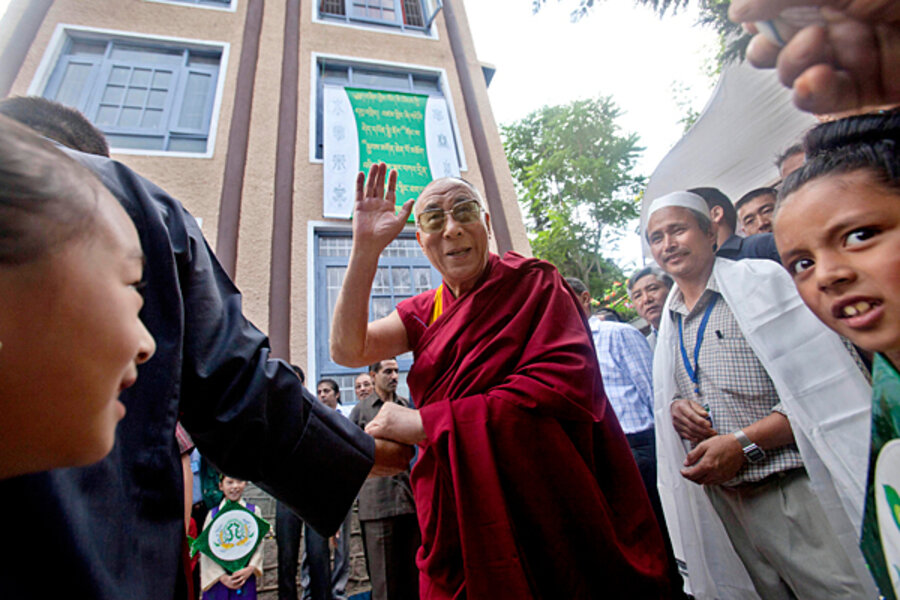Dalai Lama visits Kashmir, a disputed land like Tibet
Loading...
| Srinagar, Indian-controlled Kashmir
After a gap of 24 years, the Dalai Lama is visiting the Kashmir Valley – a region, as with the Tibetan spiritual leader's homeland, where many yearn for independence.
The Dalai Lama spoke about the futility of violence and, as with Tibet, urged people to follow the path of nonviolence, a message that some here argued was misdirected.
“Violence will lead nowhere,” the Dalai Lama told school children in Srinagar’s Tibetan colony. “Differences and disagreements should be resolved through dialogue. Violence can solve nothing; instead, it can create more problems."
Kashmir, one of the oldest remaining conflicts in the world, saw a violent armed resistance to Indian rule in the 1990s. Hundreds of thousands of Indian security forces ultimately put down the insurgency, but most of the forces have stayed on.
Over the past decade, most independence-minded Kashmiris have opted for nonviolence after seeing the ravages of war and fearing a "terrorist" label from the West after 9/11. An Indian Army officer told the press today that only about 280 to 300 militants are present across the predominantly-Muslim Kashmir Valley. The conflict in Kashmir has made a transition to more nonviolent forms of resistance such as mass protests, stone throwing, and debates and campaigns on social networking sites like Facebook and Twitter.
But the Dalai Lama’s appeal for nonviolence did not resonate with local people in Kashmir who were irked that he preached nonviolence only to the people and not to the Indian forces that are accused of gross human rights abuses in the region. Security forces have killed more than 100 unarmed youth, most during protests, in 2010. And police have detained many dissenters, some merely for what they post on Facebook.
“Considering the politics between India, Tibet, and China – and India’s support to Dalai Lama – the statement is understandable and he didn’t go beyond the official line of Indian government,” says Gul Mohammad Wani, a professor of political science at the University of Kashmir. “But he should have at least talked of the same autonomy for Kashmir that he does for Tibet.”
A 'one-sided' plea
Kashmiri separatist leaders also took strong exception to the Dalai Lama’s "one-sided plea for nonviolence" and issued statements denouncing the idea of "peace without justice."
“We respect Dalai Lama and recognize his genuine cause, but peace is only possible with justice. Until justice is done, there cannot be peace,” said Mirwaiz Umar Farooq, one of the main separatist leaders. Senior separatist leader Syed Ali Geelani called the statement, “sympathizing with oppressors instead of the oppressed.”
The six day private visit is the Dalai Lama’s third visit to Kashmir. He sites turmoil in the region as the reason for not visiting in the past 24 years. He is the top guest of the state government, which is aligned with New Delhi, and has been put up at a posh residence surrounded by heavy security.
Jammu and Kashmir's Chief Minister Omar Abdullah has been accompanying the Dalai Lama on many of his visits across Srinagar and other places.
"When I visited [Kashmir] the first time, Sheikh Mohammad Abdullah was [governing] here; second time Farooq Abdullah [his son governed] here; and now Omar Abdullah [his grandson is governing]," the Dalai Lama said.
Omar Abdullah recalled meeting the Dalai Lama on his last visit. "Much time has since passed. Our state has been through an extremely dark spell of violence," he said. "Things are now gradually improving and I request His Holiness to pray for permanent peace in the state."
Kashmir's Buddhist roots
The Dalai Lama went to the Tibetan colony in Srinagar and paid visits to places of Buddhist importance and other religious places in the valley. Apart from that, his visit to the valley is restricted to meetings with high ranking Indian officials, senior state ministers, bureaucrats, and does not include any meetings with local people, civil society organizations, or the separatist leadership.
Kashmir has a significant Buddhist past. Buddhism was the major religion here for a time; the city of Srinagar was founded by the Buddhist ruler Ashoka around 250 BC. It is widely believed that on a hill of ancient ruins almost five miles from Srinagar, the Fourth International Buddhist conference was held in the second century BC.







